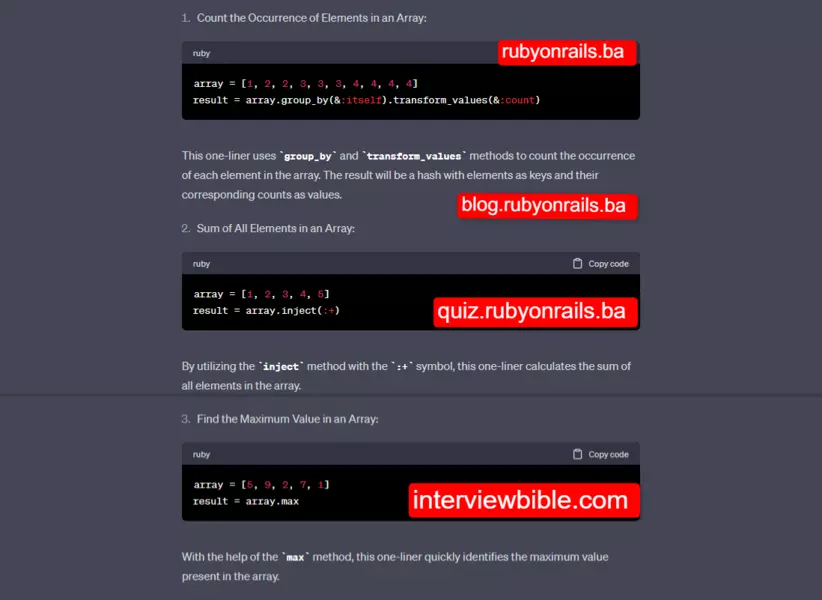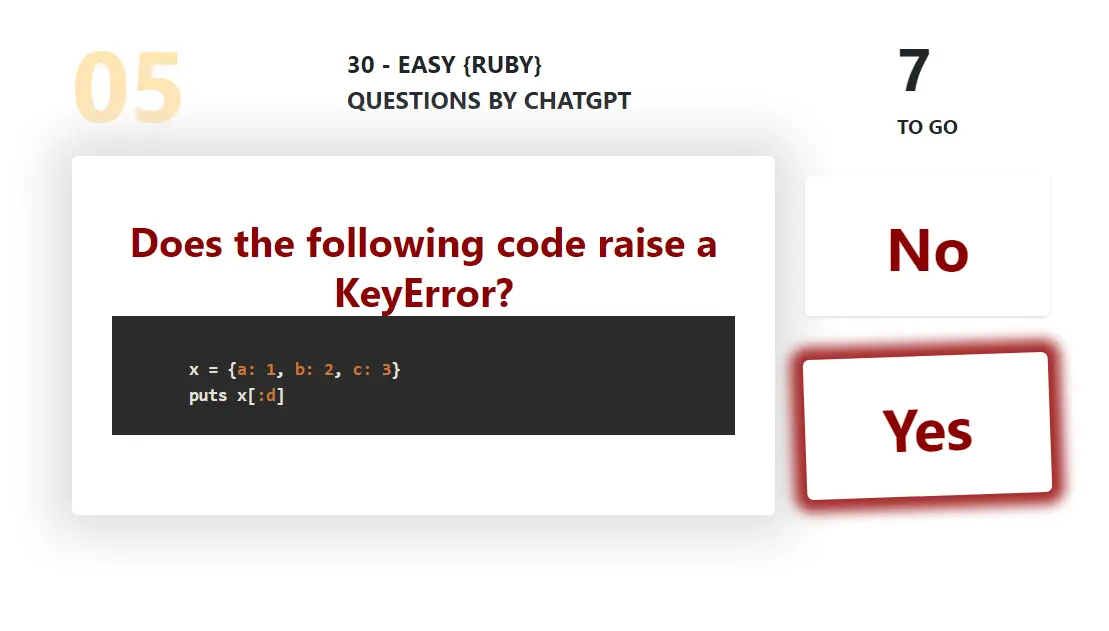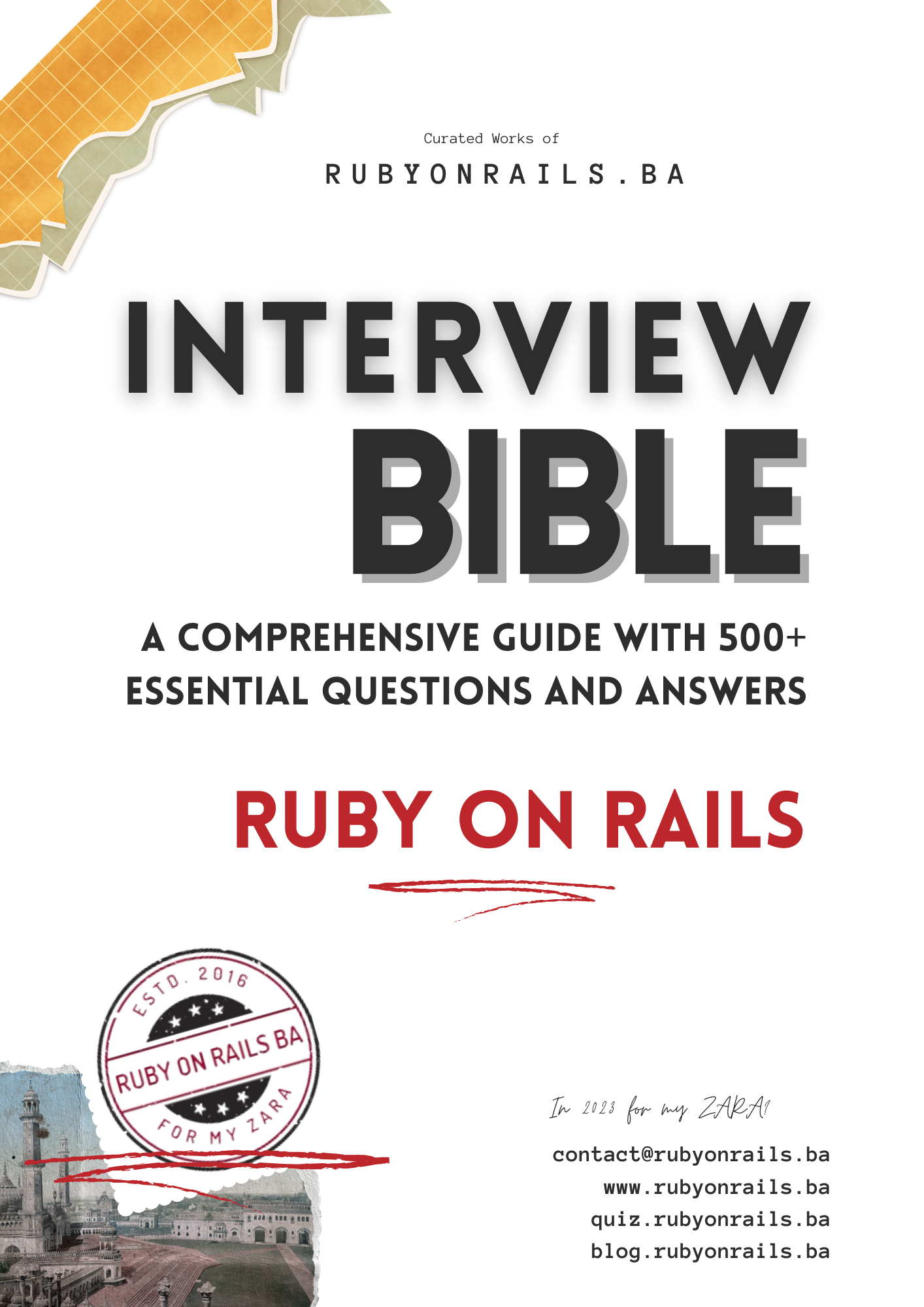
10 Useful Ruby One-Liners: Examples and Descriptions 28/05/2023 ~ Views: 2631
Introduction:
Ruby is a powerful and elegant programming language known for its readability and expressiveness. One-liners, concise lines of code that perform a specific task, are particularly popular among Ruby developers for their simplicity and efficiency. In this blog post, we will explore 10 of the most useful Ruby one-liners, complete with examples and detailed descriptions of their functionality. Whether you're a beginner or an experienced Ruby programmer, these handy code snippets are sure to enhance your productivity and make your coding journey smoother.
Ruby is a powerful and elegant programming language known for its readability and expressiveness. One-liners, concise lines of code that perform a specific task, are particularly popular among Ruby developers for their simplicity and efficiency. In this blog post, we will explore 10 of the most useful Ruby one-liners, complete with examples and detailed descriptions of their functionality. Whether you're a beginner or an experienced Ruby programmer, these handy code snippets are sure to enhance your productivity and make your coding journey smoother.
- Count the Occurrence of Elements in an Array:
array = [1, 2, 2, 3, 3, 3, 4, 4, 4, 4] result = array.group_by(&:itself).transform_values(&:count)
This one-liner uses group_by and transform_values methods to count the occurrence of each element in the array. The result will be a hash with elements as keys and their corresponding counts as values.
- Sum of All Elements in an Array:
array = [1, 2, 3, 4, 5] result = array.inject(:+)
By utilizing the inject method with the :+ symbol, this one-liner calculates the sum of all elements in the array.
- Find the Maximum Value in an Array:
array = [5, 9, 2, 7, 1] result = array.max
With the help of the max method, this one-liner quickly identifies the maximum value present in the array.
- Reverse a String:
string = "Hello, World!" result = string.reverse
This simple one-liner employs the reverse method to reverse the characters in a given string.
- Check if a String is a Palindrome:
string = "level" result = string == string.reverse
By comparing a string with its reversed form, this one-liner determines if the string is a palindrome or not.
- Remove Duplicates from an Array:
array = [1, 2, 2, 3, 4, 4, 5] result = array.uniq
Using the uniq method, this one-liner removes duplicate elements from an array, leaving only the unique values.
- Flatten a Nested Array:
nested_array = [[1, 2], [3, 4], [5, 6]] result = nested_array.flatten
This one-liner utilizes the flatten method to transform a nested array into a single-dimensional array.
- Sort an Array in Ascending Order:
array = [5, 2, 7, 1, 4] result = array.sort
By employing the sort method, this one-liner arranges the elements of an array in ascending order.
- Calculate the Factorial of a Number:
number = 5 result = (1..number).inject(:*) || 1
Using the inject method with the :* symbol, this one-liner calculates the factorial of a given number.
- Find the Average of Values in an Array:
array = [3, 6, 9, 12, 15] result = array.sum / array.size.to_f
This one-liner calculates the average of values in an array by dividing the sum of the array elements by its size, ensuring a floating-point result.
- Double the Values in an Array:
array = [1, 2, 3, 4, 5]
result = array.map { |num| num * 2 } In this one-liner, the map method is used to iterate over each element in the array and double its value. The resulting array will contain the doubled values.
- Convert Strings to Uppercase:
strings = ["hello", "world", "ruby"] result = strings.map(&:upcase)
By utilizing the map method with the &:upcase syntax, this one-liner converts each string in the array to uppercase. The resulting array will contain the uppercase versions of the original strings.
- Extract Specific Attributes from an Array of Objects:
class Person attr_accessor :name, :age
def initialize(name, age)
@name = name
@age = age
end
end people = [Person.new("Alice", 25), Person.new("Bob", 30), Person.new("Charlie", 35)]
result = people.map(&:name) In this example, we have a class Person with attributes name and age. The map method is used to extract only the name attribute from each object in the people array. The resulting array will contain the names of all the people.
These examples showcase the versatility of the map method, allowing you to transform and manipulate data in a concise and elegant manner. Feel free to experiment with map and adapt these one-liners to suit your specific use cases.
Conclusion:
Ruby one-liners are an excellent way to simplify your code and achieve concise solutions to various programming challenges. In this blog post, we explored 10 of the most useful Ruby one-liners, providing examples and detailed descriptions for each. By leveraging these powerful snippets, you can enhance your Ruby programming skills and boost your productivity. Remember to experiment and adapt these one-liners to suit your specific needs, and enjoy the elegance and efficiency of Ruby coding. Happy coding!
Ruby one-liners are an excellent way to simplify your code and achieve concise solutions to various programming challenges. In this blog post, we explored 10 of the most useful Ruby one-liners, providing examples and detailed descriptions for each. By leveraging these powerful snippets, you can enhance your Ruby programming skills and boost your productivity. Remember to experiment and adapt these one-liners to suit your specific needs, and enjoy the elegance and efficiency of Ruby coding. Happy coding!
Tags: #RubyOneliners #RubyCode #RubyProgramming #RubyTips #RubySnippets #RubyTricks #RubyDevelopment #RubyCommunity #RubyGems #RubySyntax #RubyExamples #RubyHacks #RubyShortcuts #RubyCodeSnippets #RubyNinja #RubyLearning #RubyInspiration #RubyDevelopers #RubyProjects #RubyBeginners








